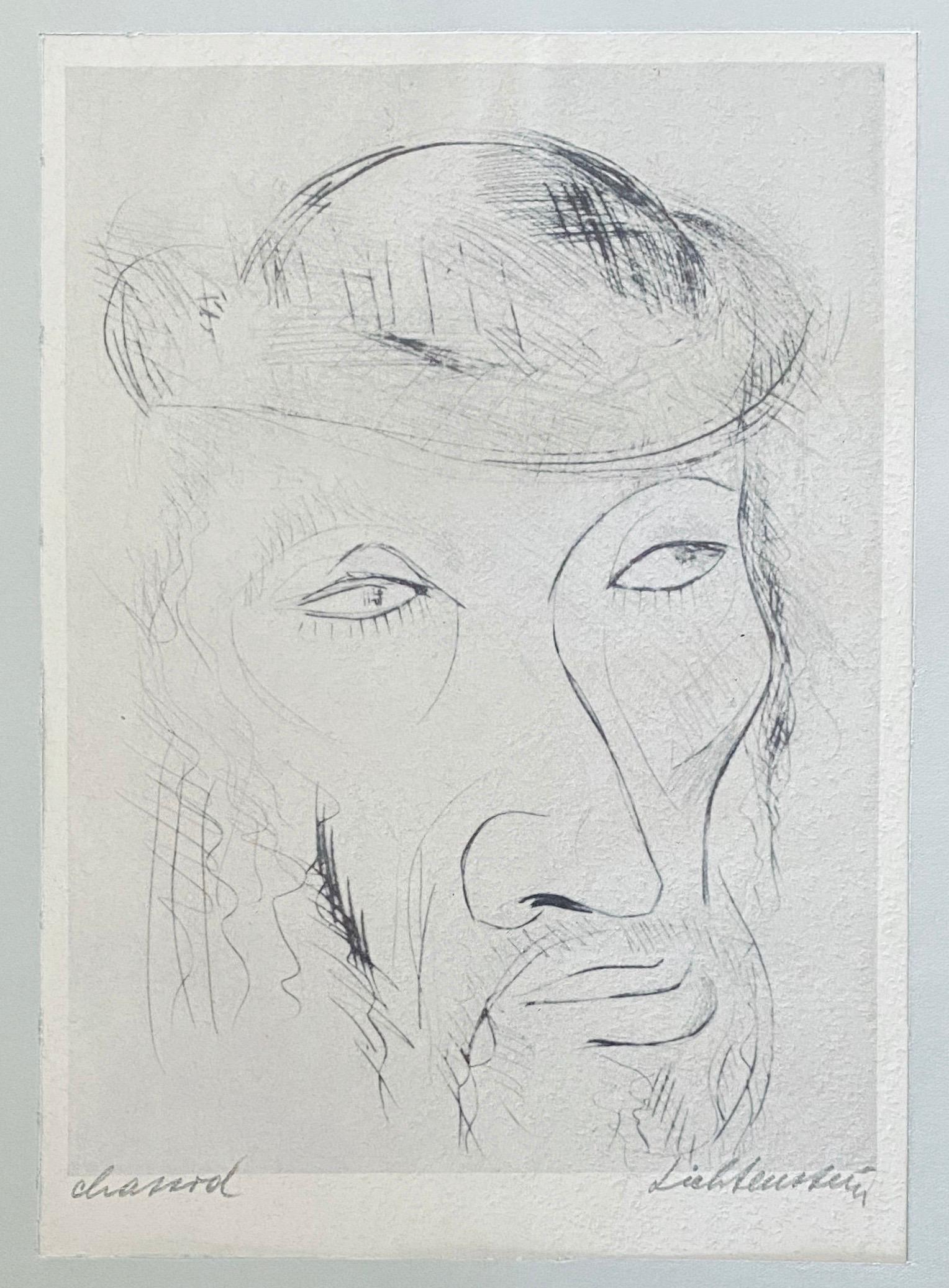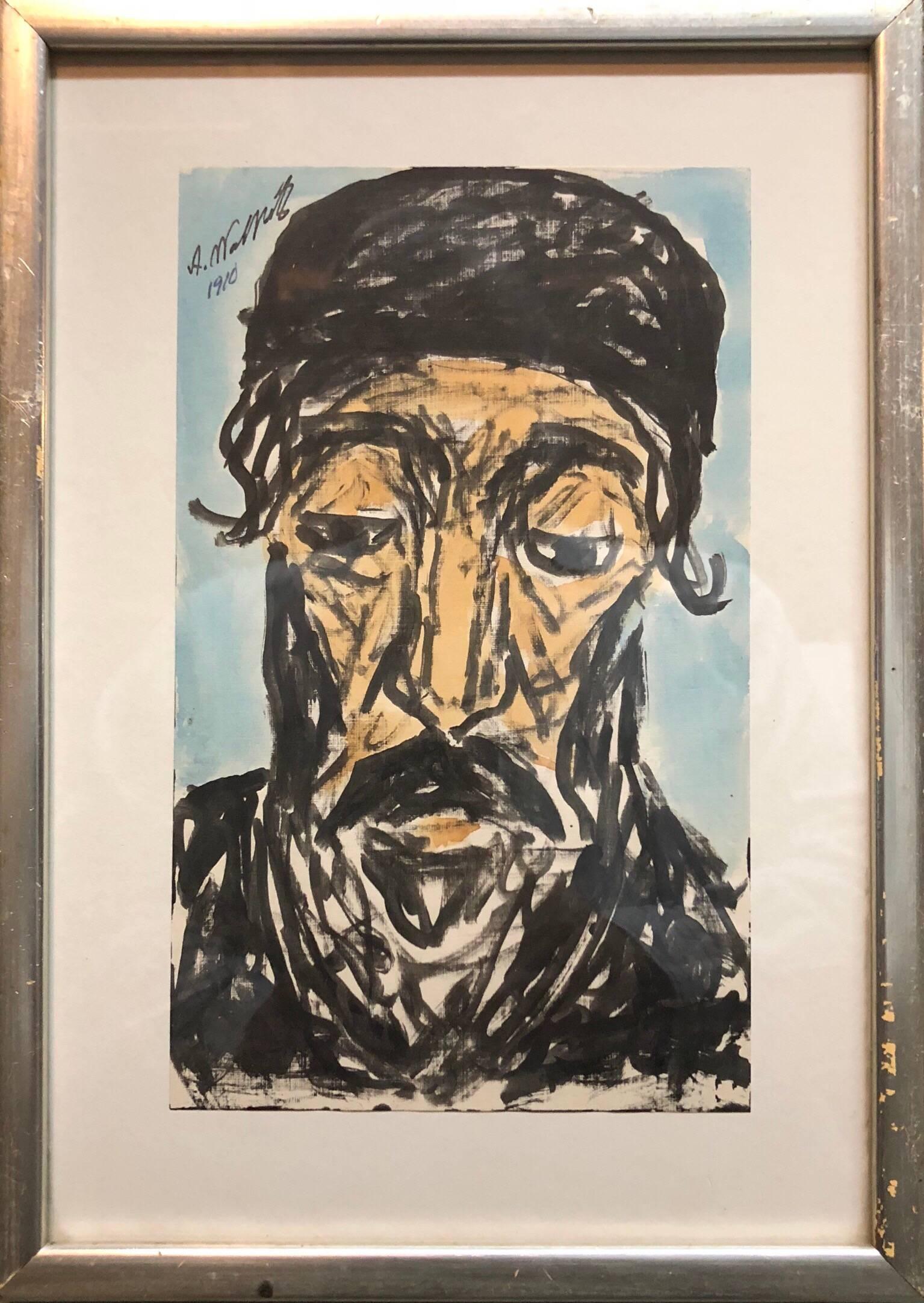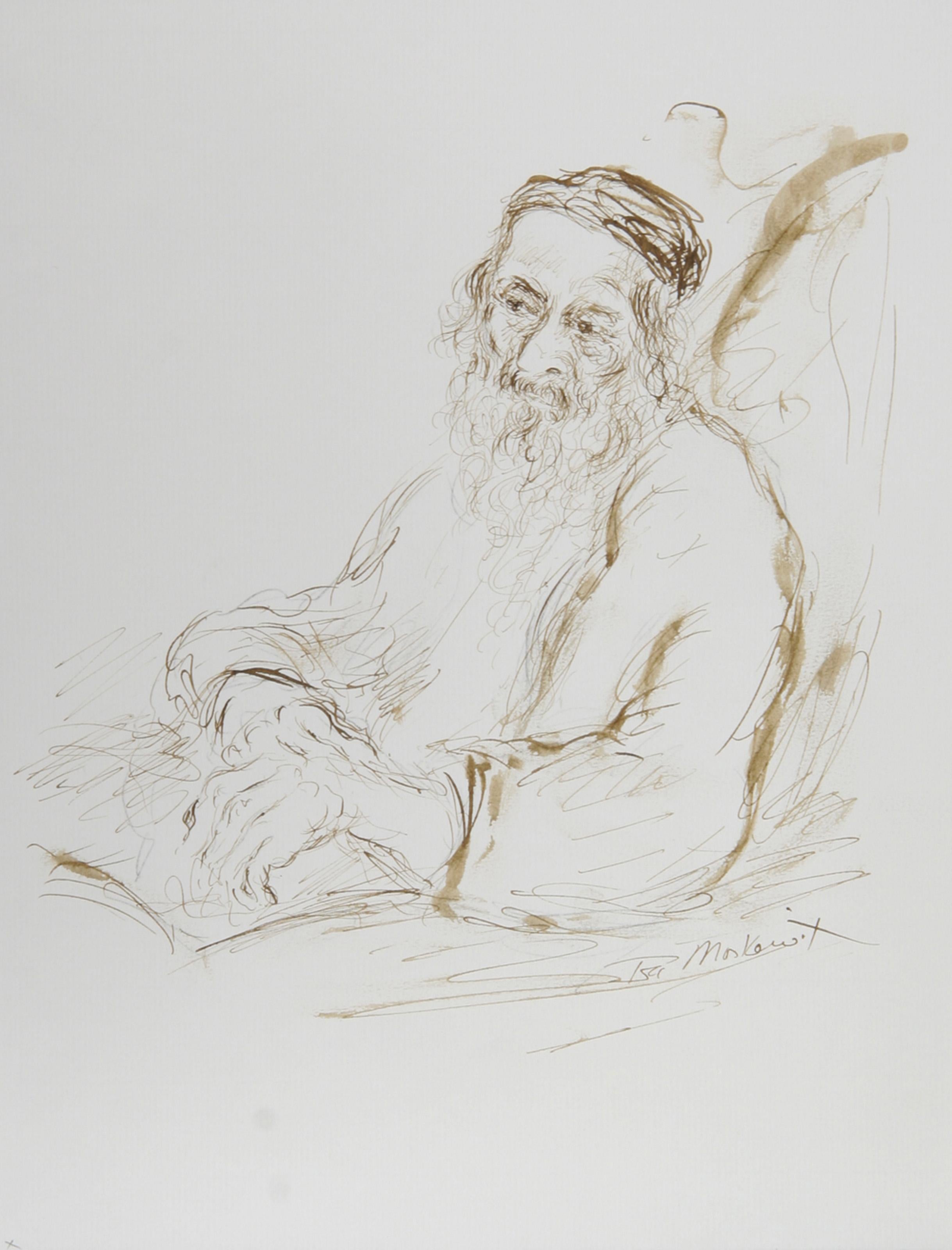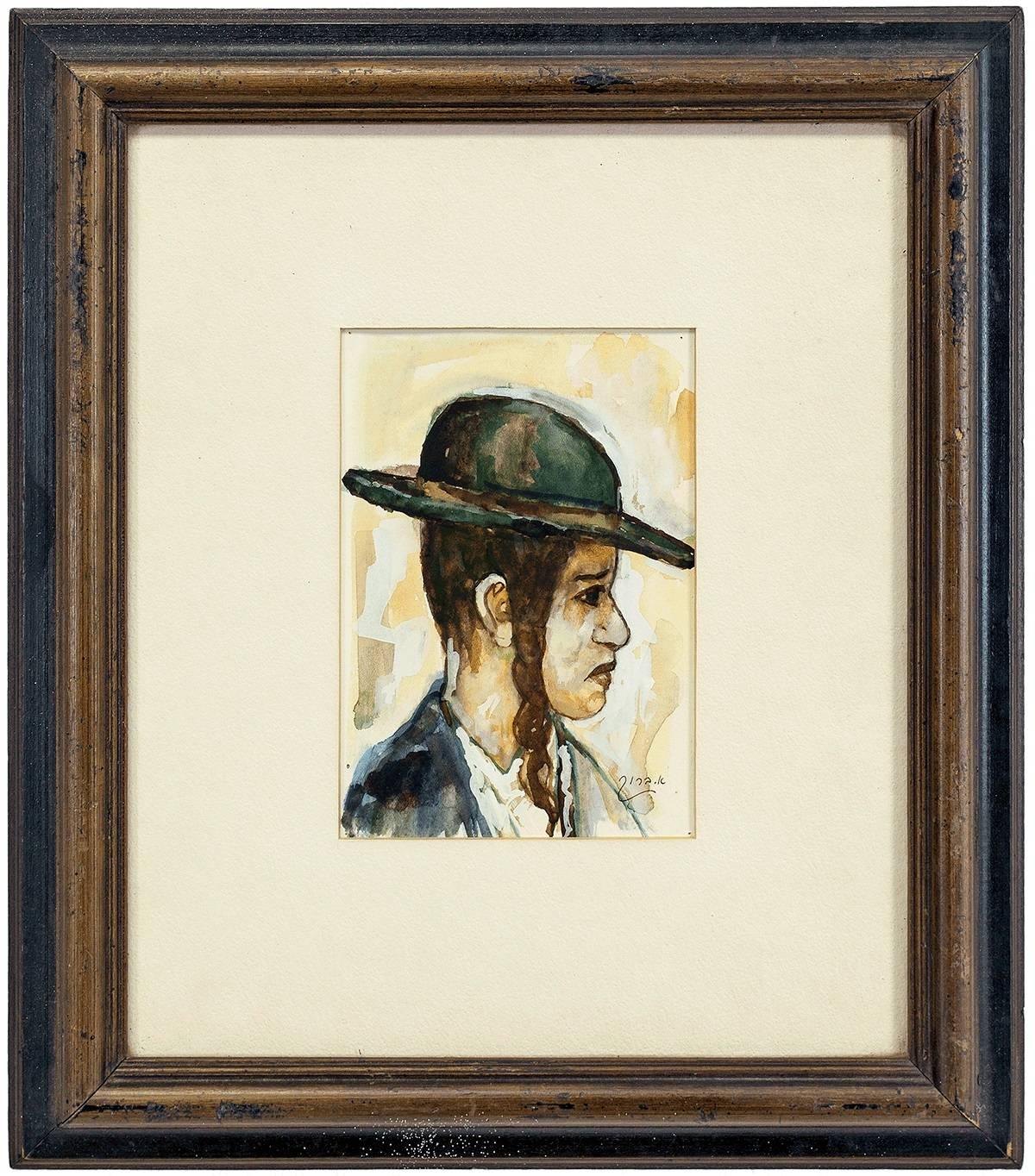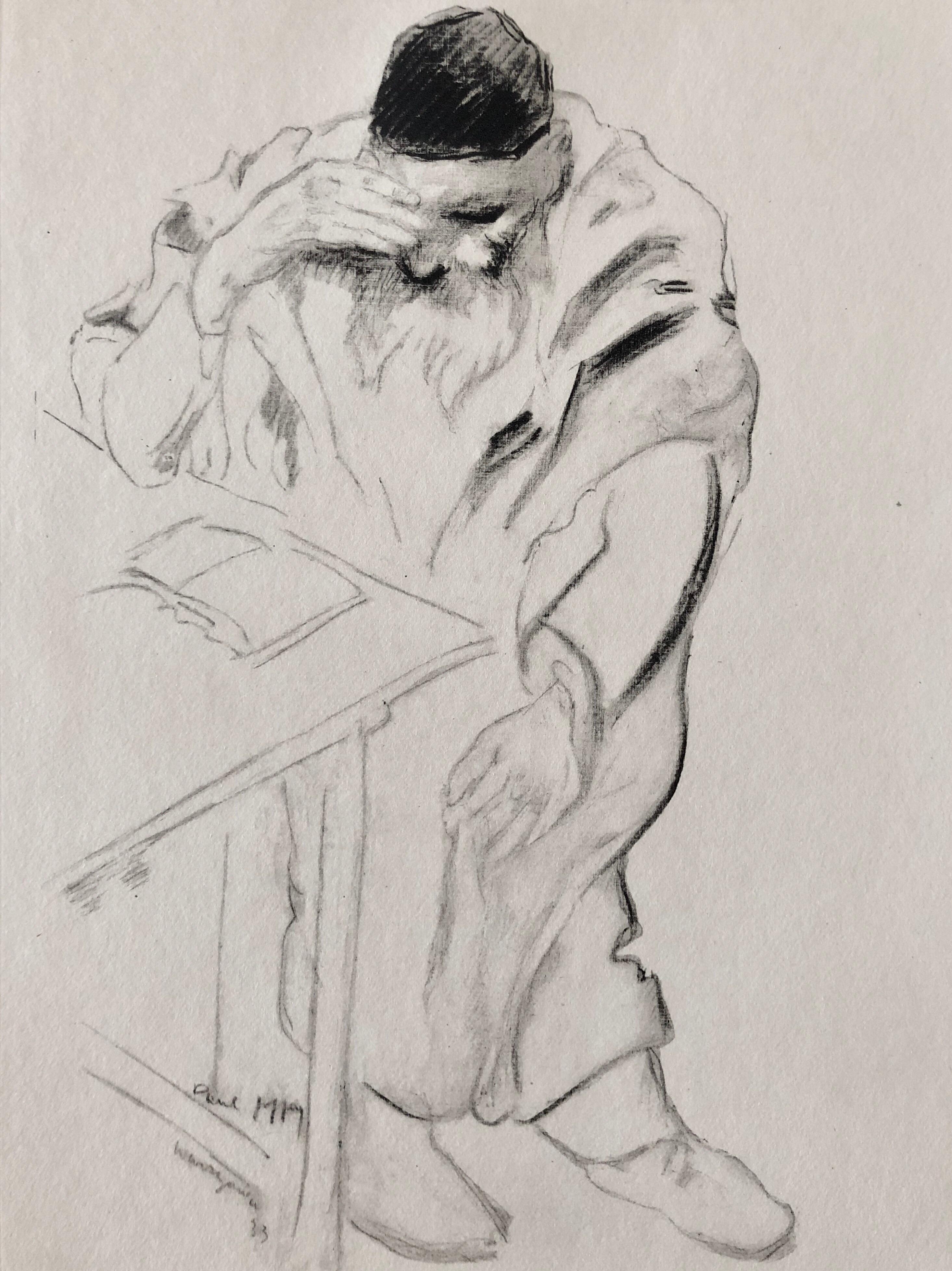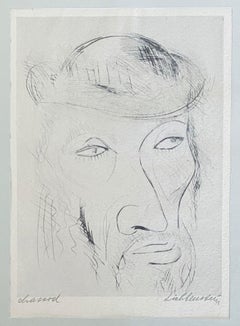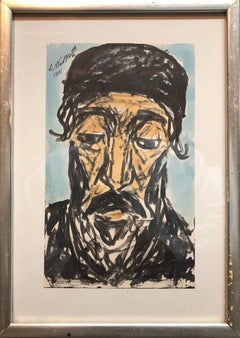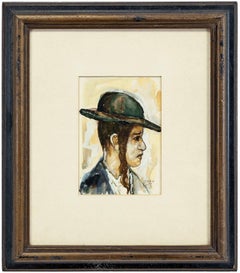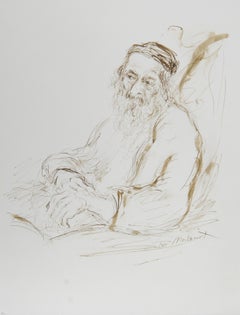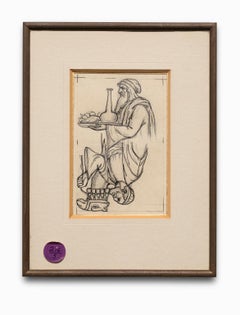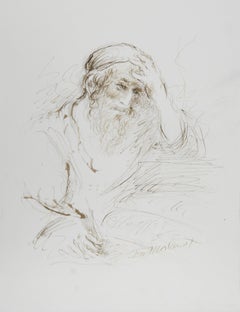Items Similar to Rare Judaica Drawing Sephardic Rabbi Gentleman, Palestine
Want more images or videos?
Request additional images or videos from the seller
1 of 7
Arieh MerzerRare Judaica Drawing Sephardic Rabbi Gentleman, Palestine
$750
£566.33
€652.63
CA$1,058.57
A$1,167.05
CHF 610.56
MX$14,317.51
NOK 7,685.76
SEK 7,187.40
DKK 4,873.89
About the Item
Dimensions w/Frame: 17 1/2" x 11 1/2"
Arieh Merzer was a prominent Israeli artist and metal worker.
Arie Merzer, an artist who worked in hand-hammered copper, was born in Warsaw, Poland in 1905, the scion of a large Hassidic family. He graduated from the Academy of Arts in Warsaw, and became the pupil of Professor Adam Richtarsky. He later worked with a group of Jewish artists who wanted to resuscitate the ancient oriental-Jewish craft of hand-hammering metal (metaloplastics), which was passed on to us as a legacy by far-off generations from the time of the Bible.
In 1928 Arieh Merzer exhibited his works in Warsaw for the first time. From 1930 he lived and worked in Paris. He was one of the Jewish artists who gathered there and were known as the Jewish 'Ecole de Paris.' Merzer regularly exhibited in the well-known 'Salon d'Automne' and 'Salon des Tuileries,' as well as in solo exhibitions in Paris and throughout France.
Arieh Merzer's work was highly acclaimed well before the Holocaust, before it became a memorial to a world destroyed. He portrayed the story of the Jewish spirit on copper, on silver, and on gold: stories from the Bible, the life-styles of the Jews in their shtetls and ghettos, of Chassidim and Kabbalists of renown, of wars of liberation and revival.
A special stress was placed on the link between the new Jewish experience and its historical nucleus. His major innovation was the moulding of mystic and traditional Jewish motifs, that surrounded the Holy Ark in Europe's burning synagogues, and presenting the results before the world of modern art. As a result he became generally recognized as an international Jewish artist.
In 1943, when France was conquered by the Nazis, Arieh Merzer escaped from a concentration camp, and after a stint in the maquis, he crossed the border into Switzerland and was sent to a labor camp. Later, he arrived in Geneva, where an album of sketches of his works was put out. In 1945 he made aliyah to Israel with his family, settled in Safed, and helped to found the Artists' Quarter there.
Arieh Merzer lived and worked in Israel for twenty-one years. His exhibitions in the country include: 1946 in the Tel Aviv Museum; 1947 in the Pevsner Artists' Pavilion in Haifa; 1951 in the Artists' Pavilion in Tel Aviv; 1955 in the Museum for Modern Art in Haifa; 1955 in the Artists' Pavilion in Jerusalem; and 1957 in the Tel Aviv Museum. His works were also on permanent show in his atelier in Safed. He was awarded prizes, including: the Herman Struck prize in 1946; the Dizengoff prize in 1951 and then again in 1965; and the Mayor of Haifa's prize in 1954. His works appear in numerous museums and collections throughout the country and abroad. His heart stopped beating on the eve of Holocaust Day, 1966.
Arieh Merzer, who was brought up in a Hassidic family, was drawn to the world of art from an early age; he was influenced by the moods and new ideals of the socialist circles and prepared himself to study art in the academy. On Passover eve , after clearing out the bread, while the rest of the household was busy preparing for the Holiday, a book fell from the bookcase and from out its pages flew dozens of sketches and drawings of nudes that the young Arieh had prepared for his folio for the entrance examinations to the academy. His sisters tore up the drawings with cries of treyfe treyfe (ritually non-kosher) and many months' hard work went down the drain. As a result of this, he left his home at the age of fifteen, and later joined a group of young artists who wanted to revive the ancient art of hand-hammered copper - metaloplastics - bequeathed to them by past generations who lived in Bible times.
Thus did he part from his family - mother, father, thirteen brothers and sisters - who all perished in the Holocaust. He alone survived, and made an oath that he would commemorate in copper all who had died.
The pictures do not do justice to this magnificent item.
- Creator:Arieh Merzer (1905 - 1966, French)
- Dimensions:Height: 17.5 in (44.45 cm)Width: 11.5 in (29.21 cm)
- Medium:
- Period:
- Condition:
- Gallery Location:Surfside, FL
- Reference Number:1stDibs: LU38211501102
About the Seller
4.9
Platinum Seller
Premium sellers with a 4.7+ rating and 24-hour response times
Established in 1995
1stDibs seller since 2014
1,803 sales on 1stDibs
Typical response time: <1 hour
- ShippingRetrieving quote...Shipping from: Surfside, FL
- Return Policy
Authenticity Guarantee
In the unlikely event there’s an issue with an item’s authenticity, contact us within 1 year for a full refund. DetailsMoney-Back Guarantee
If your item is not as described, is damaged in transit, or does not arrive, contact us within 7 days for a full refund. Details24-Hour Cancellation
You have a 24-hour grace period in which to reconsider your purchase, with no questions asked.Vetted Professional Sellers
Our world-class sellers must adhere to strict standards for service and quality, maintaining the integrity of our listings.Price-Match Guarantee
If you find that a seller listed the same item for a lower price elsewhere, we’ll match it.Trusted Global Delivery
Our best-in-class carrier network provides specialized shipping options worldwide, including custom delivery.More From This Seller
View AllBezalel School Jerusalem Israeli Judaica Etching - Chassid
By Isaac Lichtenstein 1
Located in Surfside, FL
YITSKHOK LIKHTENSHTEYN (ISAAC LICHTENSTEIN) (1888-1981) (Icchok, Izrael) was born in Lodz, Poland. Initially he was studying at Yehuda Pen school in Witebsk. In the same school wh...
Category
Early 20th Century Post-Impressionist Drawings and Watercolor Paintings
Materials
Etching
Modernist Watercolor Painting, Portrait of a Man, Judaica Rabbi
By Abraham Walkowitz
Located in Surfside, FL
Abraham Walkowitz (March 28, 1878 - January 27, 1965) was an American painter grouped in with early American Modernists working in the Modernist style.
Walkowitz was born in Tyumen, Siberia to Jewish parents. He emigrated with his mother to the United States in his early childhood. He studied at the National Academy of Design in New York City and the Académie Julian in Paris under Jean-Paul Laurens. Walkowitz and his contemporaries later gravitated around photographer Alfred Stieglitz's 291 Gallery, originally titled the Little Galleries of the Photo-Secession, where the forerunners of modern art in America gathered and where many European artists were first exhibited in the United States. During the 291 years, Walkowitz worked closely with Stieglitz as well as Arthur Dove, Marsden Hartley, and John Marin (often referred to as "The Stieglitz Quartet").
Early Career and Training
Portrait of Abraham Walkowitz - 1907 - Max Weber - Brooklyn Museum
Walkowitz was drawn to art from childhood. In a 1958 oral interview with Abram Lerner...
Category
Early 20th Century Modern Figurative Drawings and Watercolors
Materials
Paper, Watercolor
Portrait of a Rabbi
By Boris Deutsch
Located in Surfside, FL
Boris deutsch was born in krasnagorka lithuania june 4 1892 died in los angeles 1978.Entered the polytechnic school in riga 1905.School of applied arts berlin 1912. Settled in l.A. 1...
Category
20th Century Modern Figurative Drawings and Watercolors
Materials
Pastel, Mixed Media, Tempera, Watercolor
Jerusalemite Yeshiva Scholar, Judaica Watercolor
Located in Surfside, FL
Judaica watercolor portrait, Israel, signed l.r.
Category
20th Century Modern Portrait Drawings and Watercolors
Materials
Watercolor
Judaica Jewish Shtetl Etching Hasidic Rabbi "Difficult Problem" Chassidic Print
By Paul Jeffay
Located in Surfside, FL
"Probleme ardu."
Chassidic boy, Yeshiva student with open book. Judaica, Jewish scenes from a ghetto.
Saul Yaffie, a.k.a. Paul Jeffay, (1898–1957) was a Scottish Jewish artist. Know...
Category
20th Century Expressionist Figurative Prints
Materials
Etching
1950s Judaica Rabbi with Shofar Drawing
Located in Surfside, FL
UNTITLED (GREEN RABBI HOLDING A SHOFAR)
Signed S. I. Rusoff
Genre: Judaica
Subject: Religious
Medium: Pastel, Chalk
Surface: Paper
Country: United States
Dimensions: 16 1/2" x 12 3/...
Category
1950s Figurative Drawings and Watercolors
Materials
Chalk, Pastel
You May Also Like
Rabbi with Book - I, Folk Art Ink on Paper by Ira Moskowitz
By Ira Moskowitz
Located in Long Island City, NY
Ira Moskowitz, Polish/American (1912 - 2001) - Rabbi with Book - I, Year: circa 1989, Medium: Ink on Paper, signed, Size: 13 in. x 10 in. (33.02 cm x 25.4 cm), Description: Placing ...
Category
1980s Folk Art Portrait Drawings and Watercolors
Materials
Ink
"Song of Songs Illustration", Pencil and Ink, Old Testament Story
Located in Detroit, MI
SALE ONE WEEK ONLY
"Song of Songs Illustration" renders an important bibilical story that is celebrated during Jewish Passover. Song of Solomon, also called Canticle of Canticles, o...
Category
Mid-20th Century Other Art Style Figurative Drawings and Watercolors
Materials
Paper, Ink, Pencil
Rabbi with Book - II, Modern Ink on Paper by Ira Moskowitz
By Ira Moskowitz
Located in Long Island City, NY
Ira Moskowitz, Polish/American (1912 - 2001) - Rabbi with Book - II, Year: circa 1989, Medium: Ink on Paper, signed, Size: 13 in. x 10 in. (33.02 cm x 25.4 cm), Description: Holdin...
Category
1980s Modern Portrait Drawings and Watercolors
Materials
Ink
Rabbi with Book - III, Modern Ink on Paper by Ira Moskowitz
By Ira Moskowitz
Located in Long Island City, NY
Ira Moskowitz, Polish/American (1912 - 2001) - Rabbi with Book - III, Year: circa 1989, Medium: Ink on Paper, signed, Size: 13 in. x 10 in. (33.02 cm x 25.4 cm), Description: Sitti...
Category
1980s Modern Portrait Drawings and Watercolors
Materials
Ink
"Old Jew from Jaffa" original etching
By Hermann Struck
Located in Henderson, NV
Medium: original etching. This Hermann Struck etching was printed in 1919 and published in Berlin by Paul Cassirer. Plate size: 8 x 5 3/4 inches (205 x 145mm). A good impression on w...
Category
1910s Expressionist Prints and Multiples
Materials
Etching
The Old Arab Man - Original Watercolor on Paper - 19th Century
Located in Roma, IT
The Old Man is an original drawing in watercolor on paper realized by Anonymous Artist of the 19th Century.
Monogrammed on the lower left in pencil
The state of preservation of the...
Category
19th Century Figurative Drawings and Watercolors
Materials
Paper, Watercolor
More Ways To Browse
Jerusalem Drawing
Painting Of Rabbi
Jewish Rabbi Painting
Antique Judaica
Palestine Antique
Framed Rabbi
Antique Ark
Heart Gold Hammered
Jewish Copper
Geneva Bible
Gold Jerusalem Cross
Rabbi Drawing
Watercolor Greece
1930s Nude Male Paintings
Nude Male Drawing Black Frame
Charcoal Drawing Of Man
Childrens Book Art
Costume Design Drawing
